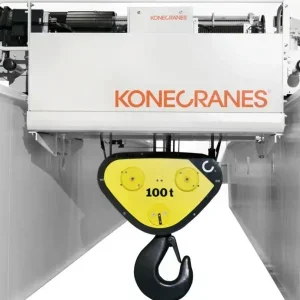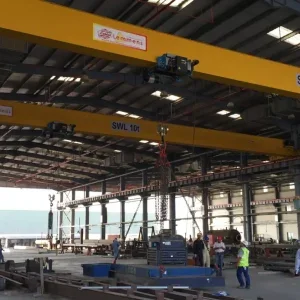Many general managers of local crane companies experienced the worst days from the fourth quarter of 2008 to the first quarter of 2009. Thanks to a RMB4tn stimulus investment by China’s government, the economy was revitalised and has been recovering gradually; the GDP in 2009 increased 8.7%.

Liqun Xiao (left) with Hoist editor Richard Howes
According to figures issued by the National Bureau of Statistics of China, total investment in fixed assets in urban areas stood at RMB16,863.4bn from January to November 2009; growth rate over the same period of the previous year was 32.1%.
RMB3,607.6bn of the total investment mentioned above was used to purchase equipment and instruments, with a growth rate of 26.1% compared to the same period of the previous year, and year-on-year growth of total investment to purchase equipment and instruments in 2005, 2006 and 2007 was 29.5%, 19.3% and 23.5% respectively. It means that the increasing rate of total investment in fixed assets in 2009 was more than in the previous three years but less than in 2005.
China’s material handling industry sector also suffered a reduction in domestic and international market demand. Growth rate of total shipments dropped sharply, from the annual rise of 29.7% in 2008 to 11.7% in 2009. Because statistics for factory cranes are not available in this national statistical system, we are only able to know the development in 2009 through some local factory crane companies, making use of the statistics provided by the Statistics Program of China Heavy Machinery Industry Association (CHMIA).
The statistics programme is a statistical organisation under CHMIA, whose function is to collect data of output and shipment monthly, offered by its member companies. The statistics show that 31 local cranes companies produced 41,995 factory crane units in 2009, with a year-on-year growth rate of 9.4%. Products are mainly factory cranes and electric hoists. Some 15 local hoist companies produced 90,029 electric hoist units (including electric wire rope hoists and electric chain hoists), increasing 0.3% in comparison with last year.
Considering the competence of member companies of CHMIA and other factors, the annual growth rate of China’s factory crane market in 2009 was estimated at around 6%.
Regarding the statistics provided by the General Administration of Customs of China, the import and export value of material handling in 2009 was $1,188.9m, down 20.8% in comparison with the previous year.
Import and export value of all kinds of hoists, jacks and winches etc was $1,524.6m, declining 11.9%, $522.8m of which was imported with a drop of 6.2%. Import and export value of all kinds of cranes was $4,454.9m with a fall of 21.5%, $677.4m of which was imported with a drop of 8.6%.
Steel and ship building are two key end user influences on the domestic crane market. As a result of the international financial crisis, China’s steel industry suffered a big decline in its market, causing some mills to close.
This was due to a combination of over capacity of enterprise and difficulties arising from the global financial crisis. As a result, China’s central government issued regulations that prohibit investment in new steel making facilities in the three years from 2009.
This will lead to a big reduction of new orders from steel mills. At the same time, many local companies felt the decline of new orders from the shipbuilding industry as new shipbuilding factories were stopped.
Crane market growth
However, the crane market is growing again with economic development a factor, for example, nuclear power construction, wind generation, railway construction and subway construction. According to statistics, five new nuclear power stations have been authorised to kick-off in 2009 and 24 nuclear generator units are under construction.
More new crane orders are expected from the nuclear power industry over the next 25 years.
Planned to absorb RMB220bn of investment, a high-speed railway from Beijing to Shanghai begun construction in April 2008, and will be finished by June 2010, spanning a distance of 1,318km.
In order to save arable land, the railway was designed to make use of overhead precast cement bridges mostly instead of normal subgrade; the distance of the overhead bridges totals 1,140km. This project requires a lot of cranes for lifting, transferring and handling, as well as specialist equipment to pave the railway tracks.
A newly unveiled plan from the Ministry of Railways shows that 9,200km of high-speed railway will be constructed from 2010 to 2012, with around RMB900bn expected to be invested in the next three years.
Subway construction will be another hot topic. A plan shows that the total distance of subway in some main cities will reach 2,500km by 2016, and only 835.5km in 10 cities were put into use. In order to relieve heavy road traffic problems, the State Council has approved a subway construction plan in 22 central cities across the country; total investment will reach RMB882bn. Subway construction will drive demand for cranes.
Last year, many local managers learnt lessons of the risk posed by the global financial crisis and began to think twice before expanding production capacities. The year also saw growth slow with an average annual rate of over 30% since 2000 ended.
However, China’s economy has just entered the beginning of its industrialisation, and big differences exist between eastern and western regions, coastal and inland areas, and city and rural locations. Therefore, there is hope that China’s economy will still grow up rapidly in the next 20 years.
China’s crane industry will keep increasing, but the growth of previous years will not be replicated. It is expected that China’s factory crane industry market in 2010 will remain equivalent to 2009 or even see a small increase.
In addition, 2009 saw several interesting developments in China’s factory crane industry:
(a) A hoist product sector within CHMIA was set up through reorganisation of the association, covering electric hoists, pneumatic hoists, manual operated hoists, balancer and related components. 102 local companies became members;
(b) Konecranes finished the acquisition of 65% of the shares in Jiangsu Three Horses Crane Manufacture Co Ltd, a leading local wire rope hoist maker. This acquisition shows that the Chinese factory crane market is open to investment, and its competition is more internationalised;
(c) Central Henan-based Weihua Group completed a total sales value more than RMB3bn in 2009, becoming the biggest crane company in China’s factory crane sector in term of sales value. The company was started in 1988, and now mainly produces overhead travelling cranes, gantry cranes and electric wire rope hoists;
(d) On the basis of a licensing agreement between Street Crane and Nanjing Hoisting Machinery General Works Co Ltd, ZX wire rope hoists are being produced and sold in the Chinese market by Street Crane’s Chinese partner.
As well as Street Crane, a lot of international brands have increased their presence in the Chinese marketplaace, including Demag, Konecranes, Abus, Kito, CM and Yale, Gorbel, GIS, Donati, GH, Hadef, JD Neuhaus and Elephant Chain Block, for example.






